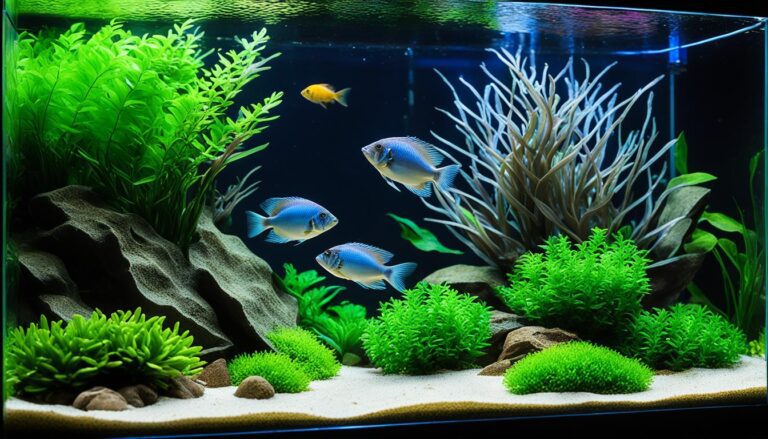Hey there! Welcome to your go-to guide on caring for the beautiful Blue Acara Cichlid. I’m really excited to share some handy tips and cool insights to help you keep these stunning fish happy and healthy. Officially known as Andinoacara pulcher, these cichlids are a popular pick among aquarists thanks to their vibrant blue spots and chill demeanor. Hailing from Venezuela and Trinidad, they’re sure to add a pop of color and energy to your tank. So, let’s dive into everything you need to know to make sure they thrive.
First things first — setting up a cozy home for your Blue Acara Cichlid means getting as close as you can to their natural habitat. You’ll want a tank that’s at least 30 gallons, giving them plenty of room to swim around. Keep the water nice and warm, ideally between 72°F and 82°F, with a pH level around 7. And don’t forget, understanding their diet and breeding habits is key to their well-being. With the right care, these little guys can live anywhere from 8 to 20 years!
Now, if you’ve got your eye on the Electric Blue Acara, you’re in for a treat. Known for their striking color and easygoing nature, these fish usually grow to about 6–7 inches long. We’ll chat more about their size, behavior, and the fascinating breeding process—did you know they fiercely guard their 150-200 eggs for several days? We’ll also cover what to feed them, including their favorite snacks like bloodworms, shrimp, and mussels. With all this knowledge, you’ll be all set to enjoy a rewarding fishkeeping adventure with these amazing cichlids!
Blue Acara Cichlid’s Natural Habitat and Behavior

The captivating Blue Acara Cichlid is a favorite in the fish tank world. They live in a variety of freshwater habitats. You can find them from calm lakes to streams in Venezuela and Trinidad. These places show how Blue Acara behave and get along with other water creatures.
The Typical Ecosystem of the Blue Acara Cichlid
These hardy fish like a tropical climate with soft to moderately hard water. The pH should be slightly acidic to neutral. The water temperature should be between 74 to 84°F. This keeps them healthy and active in their community aquarium life.
There’s a clear social hierarchy where they live. Male Acaras have long fins that show they’re in charge and ready to mate. Females can lay up to 150-250 eggs. They play a key role in growing the population.
Behavioral Traits and Social Hierarchy
The Blue Acara is usually peaceful, great for mixed tanks. But they get territorial when it’s time to breed. A pecking order forms with dominant males protecting their area and young.
Size and age decide their place in the social order. They blend well with others but can be hunters if they grow big, around 4-5 inches. This shows their flexibility. Tank management is vital to keep the peace and ensure a healthy community aquarium life.
In the table below, you’ll find how to create the best home for them:
Parameter |
Range |
Importance |
|---|---|---|
Water Temperature |
74-84°F |
Good for health and making babies |
pH Level |
5.5-7.0 |
Keeps the water right for a long life |
Water Hardness (dGH) |
5-15 |
Makes their home steady |
Egg Hatch Time |
2-3 days |
Shows the babies are doing well |
Fry Development |
Start swimming in a week |
They need to swim early to survive |
The Blue Acara is tough and can adjust well. They are interesting for both new and seasoned fish lovers. With these tips, tank enthusiasts can build a happy place. It respects the Blue Acara’s natural needs and social ways.
Tank Requirements and Setup
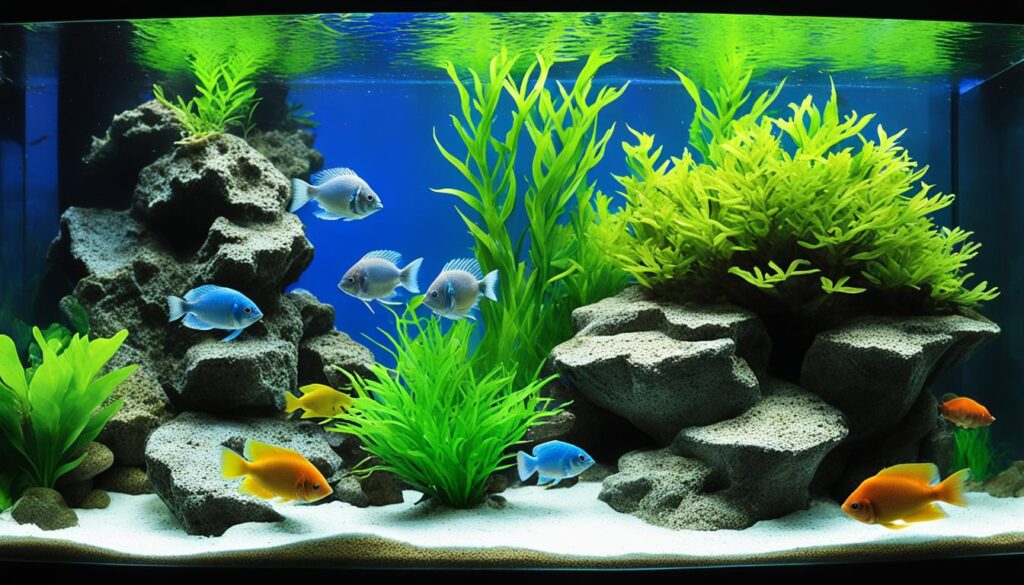
Setting up the perfect home for Blue Acara cichlids is about paying attention to key details. We’ll help you understand the best aquarium size, substrate selection, and tank decorations needed for your Blue Acara tank setup.
Choosing the Right Aquarium Size
Choosing the right size for your Blue Acara aquarium is very important. A 50-gallon tank is needed for a pair for a good life. If you want more fish or a community, you’ll need more space. For 6 Blue Acaras, a tank of at least 80 gallons is best. This gives each fish their own space and lowers stress and fighting.
Optimal Substrate and Decoration for Blue Acara Cichlids
The right substrate is important for making Blue Acaras feel at home and stay healthy. A sandy bottom is best as it’s like their natural home and helps them find food. Decorations like rocks and caves are also key. They provide hiding spots and stop fights by blocking fish from seeing each other too much.
Here’s what a good habitat looks like:
- Substrate: Fine sand or soft dirt mixed with little pebbles.
- Decorations: Caves from rocks or wood, placed to make barriers and private areas.
- Plants: Tough plants in pots so they don’t get pulled out; they also help keep the water clean and make the tank look nice.
When picking tank mates, be careful with fish that look like Blue Acaras. Electric Blue Acaras are a bit calmer. They can live peacefully with friendly fish like Astyanax tetras even in 50-gallon tanks.
Every part of your tank, from the aquarium size to the tank decorations, makes a difference. A carefully planned Blue Acara tank setup and the right substrate selection ensure your fish are both happy and healthy.
Nutritional Needs of the Blue Acara Cichlid
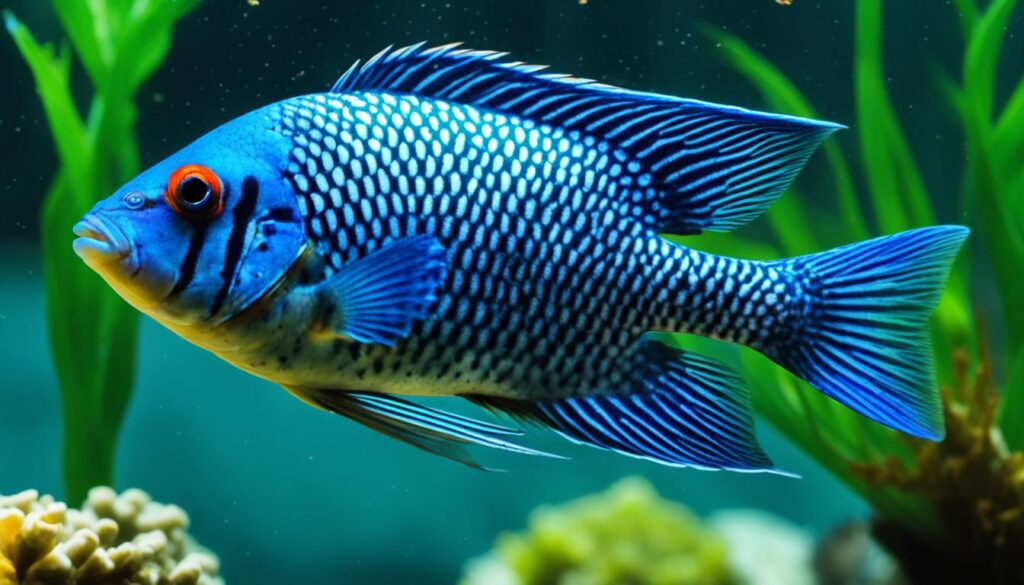
Getting to know about Blue Acara nutrition is key. They have a wide range of feeding habits. They eat both plants and meats to stay healthy and colorful in a tank.
Feeding Habits and Recommended Foods
The Blue Acara likes eating both frozen and dry foods. When they first came to their tank, they tried Frozen Blood worms and Brine Shrimp. They preferred the worms more but also enjoyed bits of shrimp wafers.
They enjoy high-quality pellets like New Life Spectrum and Hikari for daily meals. Free-dried krill and crickets add a tasty variety to their diet.
Balancing the Blue Acara’s Diet for Optimal Health
Keeping dietary health great for Blue Acara Cichlids takes more than just feeding them what they like. A variety of food like tilapia, veggie pellets, and fluval bug bites keep them vibrant and active. This balanced diet keeps them stress-free and healthy.
Watching how much and what they eat is important to prevent overfeeding. Their diet needs both meaty and green foods. This keeps their health at its best.
Water Parameters for Blue Acara Cichlids
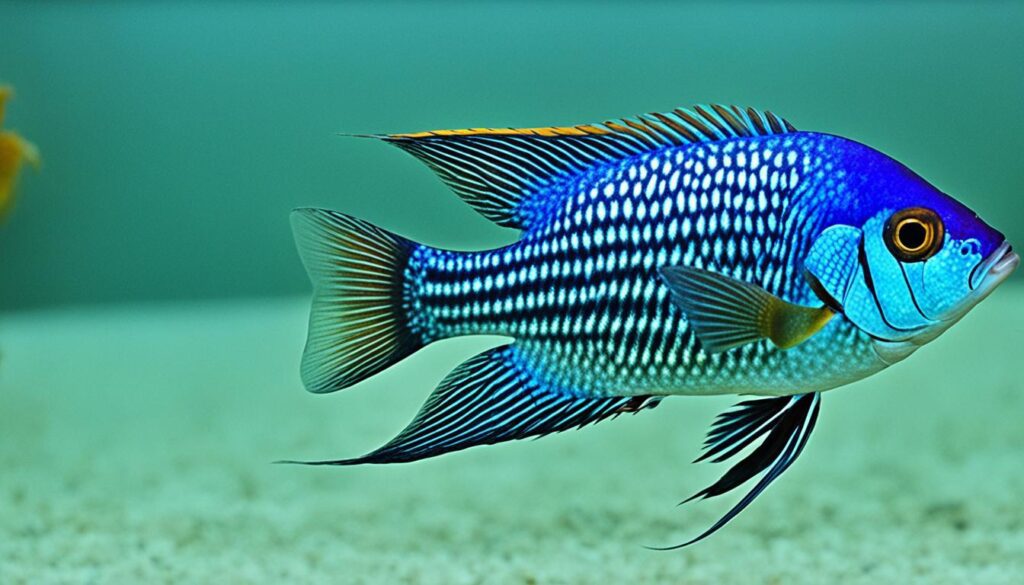
Keeping the right water parameters is essential for the well-being of Blue Acara Cichlids. These fish can adjust well, but they do best when their tank mimics their natural home. This means making sure the pH levels, water hardness, and temperature are just right. Let’s look at how to make a perfect tank environment for these beautiful fish.
Temperature control is very important. Blue Acara Cichlids live happily in water temperatures from 22–30°C (72–86°F). This range imitates their tropical home, keeps them active, and healthy. Use a good aquarium thermometer to keep the temperature stable. Avoiding temperature changes is key, as they can stress your fish.
Stable pH levels are a must. They prefer a pH between 6.5 and 8.0. This range, from slightly acidic to neutral, supports their health and prevents sickness. Regularly check the pH with a reliable meter to spot any changes early.
The right water hardness matters too. Aim for 3-6 degrees of general hardness (dGH). If the water is too hard or too soft, it can hurt their health. Use a water hardness test kit often to keep things balanced.
Here are some tips to manage water conditions:
- Get accurate testing kits for temperature, pH, and hardness.
- Do regular water changes to keep the water clean.
- Adjust the pH and hardness with water conditioners if needed.
- Check the tank’s water parameters every week to fix any issues quickly.
By focusing on these water parameters, your Blue Acara Cichlids will not just survive – they’ll flourish. Your aquarium will be full of life and color.
The Distinctive Appearance of the Blue Acara Cichlid
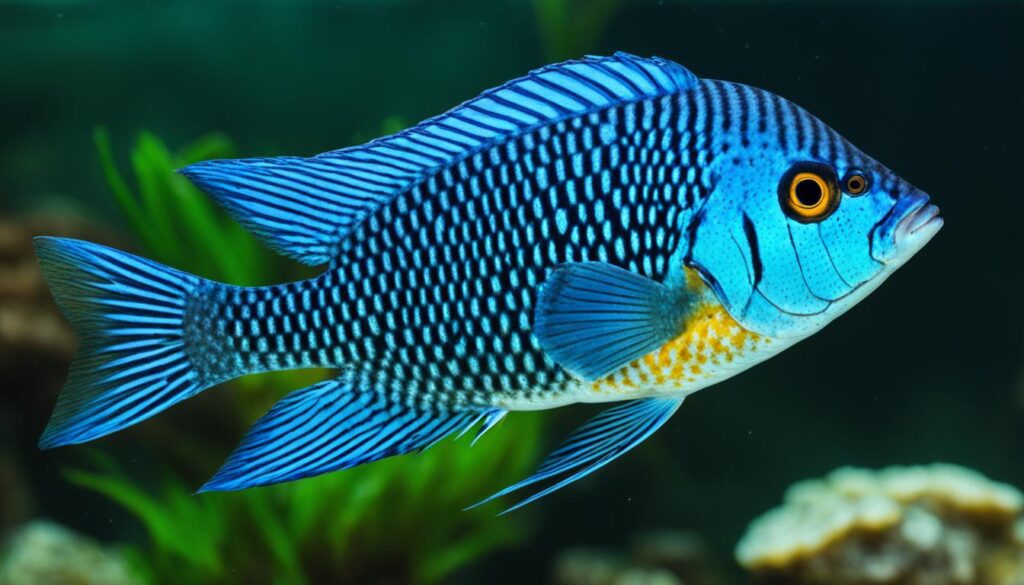
The Blue Acara appearance is truly captivating. It combines stunning colors and strong physical features. This fish is not just simple; it’s a display of nature’s creativity.
Color Patterns and Physical Characteristics
The Blue Acara Cichlid’s charm comes from its bright coloration and patterns. Its body is a mix of blue-gray with spots of electric blue. These colors make it a highlight in any aquarium.
They have long, flowing fins that might have orange hints. These fins sparkle in the light, showing off the Blue Acara physical traits.
Sexual Dimorphism in Blue Acara Cichlids
It’s easy to tell male from female Blue Acaras by looking at them. Males have larger, more pointed fins than females. They also have vibrant red on their fins, making them even more striking.
Understanding these differences is important. It helps observers but is also key for breeding and creating the right environment. Knowing about sexual dimorphism in Blue Acaras is crucial for aquarists focused on their well-being and reproduction.
Feature |
Description |
|---|---|
Base Color |
Steel blue-gray |
Spot Color |
Electric blue |
Fin Highlights |
Orange hues |
Male Fin Features |
Elongated, pointed with red outline |
In summary, the Blue Acara coloration and physical traits make it more than a pet. It’s a piece of living art. It shows how nature’s colors and genetics come together in aquarists’ tanks.
Blue Acara Chiclid Lifespan

Keeping Blue Acara Cichlids in your tank means knowing their lifespan. It’s key for their health and happiness. These fish can live different lengths depending on their care and home.
Lifespan and Growth Expectations
In good conditions, a Blue Acara can grow to 8 inches and live 7-10 years. In nature, they may live longer with more space and natural food. However, at home, their health depends on how well you take care of them.
Blue Acaras grow quickly. Their growth is affected by their diet, home conditions, and care. The right water temperature (72°F to 82°F) and a pH of 7 help them grow strong.
Common Health Issues and Preventative Care
Blue Acaras are tough but can get sick like any fish. Catching problems early is key. Watch for stress or sickness, keep the water clean, and feed them well to keep them healthy. Here’s what you can do:
- Change the water often to keep it clean and safe.
- Give them a mix of foods, like they would eat in the wild.
- Watch for any strange behavior as it may mean they’re not feeling well.
Doing these things can help your Blue Acara stay healthy and live a full life.
Criteria |
Blue Acara |
Comparison |
|---|---|---|
Lifespan (average) |
7-10 years |
Jack Dempsey: 10-15 years |
Growth to Maturity |
4 inches |
Oscar: Up to 14 inches |
Tank Size Recommended |
30 gallons |
Pleco: Requires larger tank due to size (up to 24 inches) |
Diet |
Insects, shrimp, earthworms |
Lemon Tetra: Requires smaller, more frequent meals |
Breeding Blue Acara Cichlids
Unlocking the secrets of Blue Acara breeding can enrich your fish keeping adventure. These fish are known for their strong bonds and prolific breeding. They are monogamous and show amazing behaviors when breeding. It’s crucial to adjust your aquarium’s temperature to 78-82°F. This encourages them to spawn.
Watching Blue Acara cichlids care for their young is captivating. The parents take turns looking after their eggs and fry, resembling a caring underwater family. When the fry are moved to a safe place, the adults may spawn again in just two weeks. This can keep the cycle of life ongoing in your aquarium.
Creating a safe space for Blue Acara fry is vital. Seeing them start to swim a week after hatching is rewarding. I use a sponge filter in the breeding tank to protect the fry. Watching them grow and change colors as they join the main tank is a joy. It reminds me why I love fish keeping.
